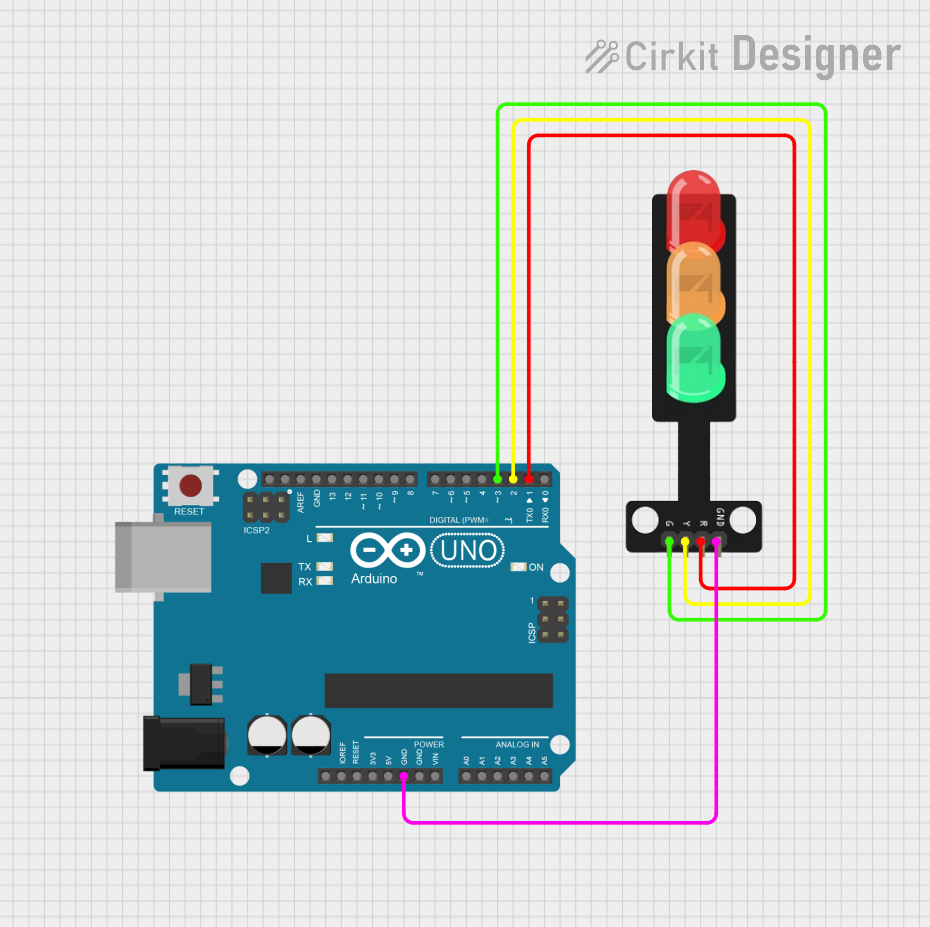
Cirkit Designer
Your all-in-one circuit design IDE
Home /
Project Documentation
Arduino UNO Controlled Traffic Light System

Traffic Light Controller Circuit Documentation
Summary
This document describes a simple traffic light control system using an Arduino UNO microcontroller and a traffic light module with three LEDs (Green, Yellow, and Red). The system operates by cycling through the LEDs in a typical traffic light sequence: green light for 5 seconds, yellow light for 2 seconds, and red light for 5 seconds. This sequence repeats indefinitely to simulate a traffic light operation.
Component List
Arduino UNO
- Description: A microcontroller board based on the ATmega328P.
- Pins: UNUSED, IOREF, Reset, 3.3V, 5V, GND, Vin, A0-A5, SCL, SDA, AREF, D0-D13.
- Purpose: Acts as the central controller for the traffic light system, driving the LEDs in the sequence programmed in the embedded code.
Traffic Light
- Description: A module with three LEDs representing a traffic light.
- Pins: Green, Yellow, Red, GND.
- Purpose: Displays the traffic light sequence as controlled by the Arduino UNO.
Wiring Details
Arduino UNO
- GND: Connected to the GND pin of the Traffic Light to establish a common ground.
- D3: Connected to the Green LED of the Traffic Light.
- D2: Connected to the Yellow LED of the Traffic Light.
- D1: Connected to the Red LED of the Traffic Light.
Traffic Light
- Green: Connected to pin D3 on the Arduino UNO.
- Yellow: Connected to pin D2 on the Arduino UNO.
- Red: Connected to pin D1 on the Arduino UNO.
- GND: Connected to the GND pin on the Arduino UNO.
Documented Code
/*
* This Arduino sketch controls a traffic light system.
* The traffic light has three LEDs: Green, Yellow, and Red.
* The sequence is as follows:
* - Green LED is on for 5 seconds
* - Yellow LED is on for 2 seconds
* - Red LED is on for 5 seconds
* This sequence repeats indefinitely.
*/
// Pin definitions
const int redPin = 1; // Red LED connected to pin D1
const int yellowPin = 2; // Yellow LED connected to pin D2
const int greenPin = 3; // Green LED connected to pin D3
void setup() {
// Initialize the digital pins as outputs
pinMode(redPin, OUTPUT);
pinMode(yellowPin, OUTPUT);
pinMode(greenPin, OUTPUT);
}
void loop() {
// Green LED on for 5 seconds
digitalWrite(greenPin, HIGH);
delay(5000);
digitalWrite(greenPin, LOW);
// Yellow LED on for 2 seconds
digitalWrite(yellowPin, HIGH);
delay(2000);
digitalWrite(yellowPin, LOW);
// Red LED on for 5 seconds
digitalWrite(redPin, HIGH);
delay(5000);
digitalWrite(redPin, LOW);
}
Filename: sketch.ino
Description: The code defines three pins corresponding to the red, yellow, and green LEDs of the traffic light. In the setup() function, these pins are configured as outputs. The loop() function then controls the LEDs in the specified sequence, turning each on and off for the designated duration.